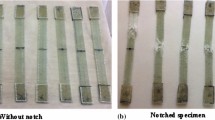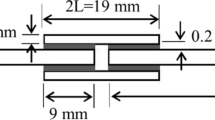Abstract
The adhesive layer plays an important role on the stress and deformation transfer between composite patch and parent plate in a repaired structure. In this paper, based on the nonlinear material properties and continuum damage mechanics, the three-dimensional progressive damage model of the repaired specimen has been built to investigate the effect of initial adhesive disbonding on the ultimate strength and the damage state. The results indicate that the initial adhesive disbonding does not change the final failure mode, but results in the decrease of the final failure load. The decreasing amount of final failure load for the repaired specimen with four-layer patch is larger than that for the repaired specimen with two-layer patch.








Similar content being viewed by others
References
Rao VV, Singh R, Malhotra SK (1999) Residual strength and fatigue life assessment of composite Patch repaired specimens. Compos Part B Eng 30:621–627
Bachir Bouiadjra B, Oudad W, Albedah A, Benyahia F, Belhouari M (2012) Effects of the adhesive disband on the performances of bonded composite repairs in aircraft structures. Mater Des 37:89–95
Benyahia F, Albedah A, Bachir Bouiadjra B (2014) Analysis of the adhesive damage for different patch shapes in bonded composite repair of aircraft structures. Mater Des 54:18–24
Ahn SH, Springer GS (1998) Repair of composite laminates-II: models. J Compos Mater 32:1076–1114
Kashfuddoja M, Ramji M (2015) Assessment of local strain field in adhesive layer of an unsymmetrically repaired CFRP panel using digital image correlation. Int J Adhes Adhes 57:57–69
Cheng XQ, Zhao WY, Gao JY, Bao J (2013) Influence of adhesive properties on tensile behavior of scarf repaired laminates. J Beijing Univ Aeronaut Astronaut 39:1144–1149
Kim MK, Elder DJ, Wang CH, Feih S (2012) Interaction of laminate damage and adhesive disbonding in composite scarf joints subjected to combined in-plane loading and impact. Compos Struct 94:945–953
Liu X, Wang G (2007) Progressive failure analysis of bonded composite repairs. Compos Struct 81:331–340
Hashin Z (1980) Failure criteria for unidirectional fiber composites. J Appl Mech 47(2):329–334
Lessard LB (1989) Compression failure in laminated composites containing an open hole. Ph.D. Dissertation, Stanford University, Stanford, USA
Ye L (1988) Role of matrix resin in delamination onset and growth in composite laminates. Compos Sci Technol 33(4):257–277
Ochoa OO, Reddy JN (1992) Finite element analysis of composite laminates. Nasa Sti/recon Techn Rep A 94(1):37–109
Sleight DW (1999) Progressive failure analysis methodology for laminated composite structures, NASA/TP-1999-209107. NAS, USA
Chang FK, Lessard LB (1991) Damage tolerance of laminated composite containing an open hole and subjected to compressive loadings: part I—analysis. J Compos Mater 25:2–43
Pietropaoli E (2012) Progressive failure analysis of composite structures using a constitutive material model (USERMAT) developed and implemented in ANSYS. Appl Compos Mater 19:657–668
Kim DH, Jung KH, Lee IG et al (2017) Three-dimensional progressive failure modeling of glass fiber reinforced thermoplastic composites for impact simulation. Compos Struct 176:757–767
Campilho RDSG, De Moura MFSF, Pinto AMG, Morais JJL, Domingues JJMS (2009) Modelling the tensile fracture behaviour of CFRP scarf repairs. Compos Part B Eng 40(2):149–157
Wang YQ (2010) Progressive damage analysis on the design of repairs to aircraft composite structure. Ph.D. Dissertation, Nanjing University of Aeronautics and Astronautics, Nanjing, China
Ridha M, Tan VBC, Tay TE (2011) Traction–separation laws for progressive failure of bonded scarf repair of composite panel. Compos Struct 93:1239–1245
Acknowledgements
The authors appreciate their supports from China Postdoctoral Science Foundation Funded Project (2016M602256), Henan Province Science and Technology Key Project (172102210001) and the Opening Project of Dike safety and Disease Prevention Engineering Technology Research Center of Ministry of Water Resources (Grant no. 201607).
Author information
Authors and Affiliations
Corresponding author
Additional information
Technical Editor: André Cavalieri.
Rights and permissions
About this article
Cite this article
Tie, Y., Xu, P., Li, C. et al. Effects of the initial adhesive disbonding on patch repaired composites. J Braz. Soc. Mech. Sci. Eng. 40, 225 (2018). https://doi.org/10.1007/s40430-018-1149-x
Received:
Accepted:
Published:
DOI: https://doi.org/10.1007/s40430-018-1149-x




